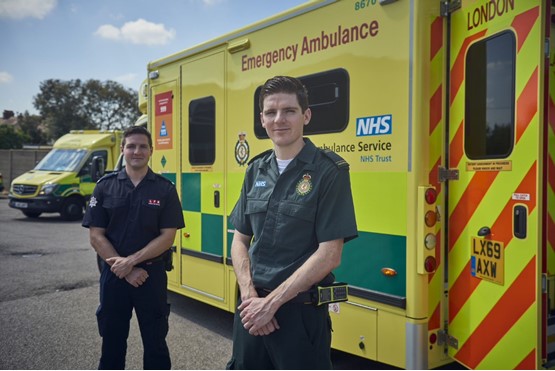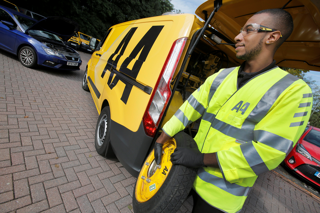This article originally appeared in the May issue of Fleet News available as a digital edition.
Justin Wand, director – strategic assets and property at London Ambulance Service (LAS), has faced significant challenges with logistics, vehicle preparation, supply and maintenance across the trust at the UK epicentre of the Covid-19 pandemic. As told to Tom Seymour.
7am: Start work from home office
I’ll check emails, call or video conference colleagues and we’re generally in contact on almost an hourly basis throughout the day. The guidance is changing rapidly and we have to respond quickly.
8am: Check operational fitness of the fleet
Call demand for ambulances went from 3,500 a day pre-lockdown to 11,500 a day so we had to flex the fleet size rapidly.
Our usual fleet of 1,076 vehicles, including ambulances, light commercial vehicles, rapid response cars and motorbikes had to be scaled up with an additional 176 ambulances in just three weeks to meet the demand necessary due to the coronavirus pandemic.
That 16% increase was made possible by extending end-of-contract vehicles, making sure they were ‘battle ready’ with full service, MOT, as well as running gear and gearbox overhauls.
We also pulled forward orders for the replacement vehicles, including the preparation of specialist equipment fitting in Ireland and shipping them to London before any border lockdowns were put in place.
You can’t just go down the road and hire 176 ambulances like you can some white vans.
Support from Stagecoach and South East Ambulance Service with logistics and donating equipment meant we could have the vehicles we needed ready in time.
We would normally be able to prep new ambulances at a rate of five a week, but this had to increase to 20 a week over a three-week period.
We’re going to keep these additional 176 vehicles because we can’t afford not to have this capacity should a second wave hit later this summer and then into the winter which is always a busy period for us. We’ll keep rotating vehicles in use and it’s our plan to make them a national fleet resource in times of crisis like this.
9am: Check workshop capacity and job schedules
We have 12 London garages to keep vehicles on the road but we knew we needed more resources and The AA kindly stepped in to help us with 41 patrols and a total of 176 additional mechanics. It meant they could continue working, rather than being furloughed as they may have been due to the drop in demand from the lockdown.
Our internal specialist mechanic teams helped to train The AA teams to make sure they had the technical knowledge necessary to service and repair ambulances to make sure downtime was minimised as much as possible. Some of The AA’s teams also cover 24-hour breakdown repair for us and have been helping on site at A&E locations to do roadside repairs when needed to help minimise downtime even further.
As a result, the ambulance fleet is running at between 92-95% operational capacity.
10am: Update on vehicle deep cleaning
All these vehicles need to be washed, stocked and deep cleaned if they have been in contact with a confirmed or suspected Covid-19 patient.
This additional work means four extra hours of downtime per vehicle and this is even before restocking.
We have teams from supplier Interserve working to disinfect vehicles with anti-static cleaning agents. This is a manual process, but we’re currently testing an ultraviolet solution that is unmanned and will hit every surface inside and out of the vehicle. This will rapidly cut our preparation time down from four hours to 35 minutes. It takes just a few minutes to reset.
This will give ourselves and our paramedics much greater assurances of the decontamination process. If we’re successful with our testing of this new technology it will be shared with the Department for Transport (DfT) and Public Health England to inform policy for the rest of the vehicle preparation and vehicle logistics industry.
Noon: Check in with the teams
You have to trust people to do what they need to do. We’re working and collaborating with pragmatism and our whole lives have been transformed. Can we honestly say that we’re going to spend that 20-minute journey for a face-to-face meeting again when we know we can video conference remotely?
Whatever happens after this, it’s going to change our working patterns and that will be liberating. It’s going to be a challenge for the NHS to navigate how it resets, rather than returning to business as usual. It’s going to push us to be more innovative with how we deliver services in the future.
There has been so much variety in what’s happening each day. This level of preparedness day in, day out can cause anxiety for the teams and you have to be aware of that.
In order to prepare for the emergency Nightingale Hospital at the ExCeL Conference Centre, the teams were putting in 72-hour shifts to get 16 vehicles prepped in time.
It’s absolutely tragic the number of people in the UK and across the NHS that have lost their lives fighting the pandemic and LAS hasn’t been untouched by that.
I am working from home, but I’m also still doing face-to-face with the teams where appropriate to give them the chance to ask questions and talk.
We have always taken mental health seriously, so team members have an initial ‘hot debrief’ after certain jobs with their peers, there will be a welfare check-in after that and then there’s also access to occupational health workers.
We’ve put break rooms in place at A&Es across London where there is access to food and refreshments and it’s a place where teams can take a quiet five minutes if they need it.
2pm: Check stock levels across our stations
We consolidated our 63 ambulance stations down to 30 to help reduce the logistical burden of stocking that many sites. It means we can concentrate on those specific locations and it’s something we will keep going with until at least September. We have also established three new warehouses where we have consolidated our kit supply to restock our vehicles.
As you can imagine, there is a lot going on so the management team at LAS has gone to a seven-day week, with five days on, two days off. We’ve also brought in executive support and additional resources from the British Army to help with logistics management and that has been a big help.
4pm: Review PPE offers
In the early days, the availability of personal protective equipment (PPE) was somewhat haphazard, but we’re now at a level where it’s not as much of a challenge. Anyone on the team that wants PPE has access to it.
We’re getting a lot of offers to provide us with additional PPE, but the biggest challenge for me has actually been sorting through them to find out what is genuine and what is of the correct standard.
Some are from well-meaning individuals and some are fraudulent, so it’s been an unexpected part of the job in recent weeks to make sure we have the right level of supply for paramedics and the teams.
6pm: Review daily Government briefing
We’re taking our cues just like everyone else from the daily Government briefings and guidance from Public Health England. We’re not getting a heads-up ahead of anyone else, so every day we have to think about what has been said and how that will affect the fleet and the teams the following day. Changes in the rules could mean an increase in calls coming in potentially and we have to be ready.
We have to look at the rules that are coming in and then we’ll discuss internally to see how we can get that messaging right in plain English out to all the team and paramedics as quickly as possible.
I’ve always been immensely proud of what I do, but this situation has taught me the true power of working in a team that is connected, collaborative and has been agile to the needs of patients. You have to plan for the worst and hope for the best.
Frontline fleets: Case studies
Jack Binder, paramedic at London Ambulance Service (LAS) and Tom Binder, leading firefighter at London Fire Brigade 
London Ambulance Service paramedic Jack Binder and his London Fire Brigade brother, leading firefighter Tom Binder, have been working together responding to those in need across the capital as part of a new bluelight partnership to help boost the ambulance service’s response to Covid-19.
The new partnership across the two emergency services has helped the ambulance service respond to the demands of the Covid-19 crisis with up to 300 staff from London Fire Brigade helping to drive ambulances and assist medics as directed.
The bluelight brothers are both from Essex and have worked on several shifts together since Tom, 28, started his secondment with the ambulance service a month ago.
Tom says: “I really wanted to help make a difference during this global pandemic and help to take pressure off the ambulance service. After hearing first-hand from Jack and listening to what he does on a day-to-day basis, I didn’t want to turn down this chance down.”
Jack adds: “It has been great working so closely with Tom and responding to patients together. Though I’m not sure he enjoys taking instructions from his younger brother!
“It’s a unique experience and I don’t think anyone could have predicted this would happen a few months ago.”
Growing up, the pair were inseparable. With Jack, at 27, just a year younger than Tom, they often get mistaken for twins at work.
Joining the London emergency services came naturally to the brothers, according to Jack: “Blue lights definitely run in our blood!”
Tom adds: “Our grandparents were both in the Metropolitan Police and our dad is a retired group commander in the Brigade.
“Hearing all the stories and jobs that they would go to, I could see no other career option growing up. It’s all I ever wanted to do.”
Since being seconded to London Ambulance Service, Tom has responded to a variety of jobs across the capital. He says: “I have been to everything from attending to a new-born baby to suspected strokes and cardiac arrest patients.”
He has found the training he received as a firefighter in immediate emergency care and incident command has proved really useful and he has been able to easily apply it to his role while working alongside medics.
Jack said: “I’m really proud of my brother. Not just with his willingness to help during this crisis but also with everything he has done at the London Fire Brigade. He often rings me after his shifts and speaks with so much enthusiasm for everything he is doing at London Ambulance Service.”
The partnership has been a great learning experience for both the medics and the firefighters involved and has helped the ambulance service continue to respond to the most seriously ill and injured patients during the peak of the pandemic.
Tom said: “Bluelight services have always had a good working relationship. This partnership is only going to make things even better.”
You can read the article in the May issue of Fleet News, by clicking here
In tomorrow's frontline fleets, Justin Laney, general manager – fleet at John Lewis Partnership, reveals the impact the Covid-19 crisis has had on JLP. He offers an insight into a typical day in the life of his fleet operation.
Keep up to date with Covid-19 news and guidance
For the latest fleet guidance on Covid-19, click here
For answers to questions from our Covid-19 webinar, click here
For the latest fleet-specific Covid-19 news, click here
The BVRLA has produced a guide to operating during the pandemic, access it here


















Login to comment
Comments
No comments have been made yet.